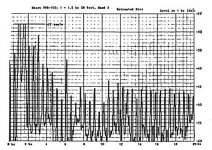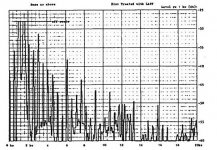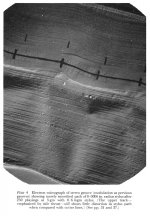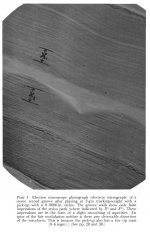What on earth are you on about?You can replace the tip but the increased distortion on the plastic is cumulative. Just gets worse.
-Richard
The old records up until c. 1950 or so were band width limited at about 6 kHz because the tracking weights and carts damaged the HF above that so severely after a few plays it basically render then useless.
Olson published about his experiments on preferred bandwith in 1947 and it obviously needed some time until such results really had an impact.
It was only after the advent of better carts (still not at the quality of stuff produced after say the 1970’s) that the response was able to be extended. The big breakthrough came with the require to wider Bsnd width and better tracking demanded by quadraphonic systems.
Interestingly the British manufacturers were (allegedly) the first featuring the full bandwidth (means up to at least 15 kHz) already in the beginning of the 1950s.
I hadn't heard about it before, but (wasn't it DECCA ? ) it was the result of some military developments that required larger bandwidth.
Wrt record wear, Hirsch & Loescher used in their experiments the Shure M91 cartridges and still found that wet play reduces tip wear and record groove damage as well.
What on earth are you on about?
Groove damage caused by stylus wear.
Richard, you have to track at 1-2 grams to not cause any wear damage. Someone here mentioned that new vinyls actually get a bit quieter after a few dozen plays on a decent system. I suspect its a bath tub type profile so that after a few thousand plays, you may lose some HF information, or it will distort slightly. However a few thousand plays is highly unlikely - If I really like a record I'll play it once every other a day for say a month and then not go back to it for 2-3 months and after a year only once every 6 months or so.
Last edited:
and Shure carts worked at 0.75mg...right?
Had a V15 myself. Tracked at 1.5g since it sounded better than if too low. Reason for abandoning vinyl was because really don't like clicks and pops. However, Jam tells me I should get back into it because in some ways it is still better than digital. Told him I can't afford the equipment he has. He said, don't need that level just to get started, maybe $6,000 would be enough for a decent turntable/cart setup. Still steeper than a Benchmark DAC and quite a few others too.
Last edited:
Walton (who worked at decca) said under 3g VTF and under 1mg effective mass and all was good (and did measurements to back that up). George showed that, after 150 plays THD went down. Only a tiny bit mind.Groove damage caused by stylus wear.
Richard, you have to track at 1-2 grams to not cause any wear damage. Someone here mentioned that new vinyls actually get a bit quieter after a few dozen plays on a decent system.
He said, don't need that level just to get started, maybe $6,000 would be enough for a decent turntable/cart setup. Still steeper than a Benchmark DAC and quite a few others too.
Clearly my stuff is 4th rate. Although replacement value of arm and turntable is some silly number now (30 and 20 years old respectively). I would not get into vinyl from a standing start now.
On the subject of too little tracking force, does the following hold water?
Vinyl FAQ 09: What is tracking force? - The Vinyl Factory
Too little tracking force and the external forces applied to the stylus in the groove will overcome the stylus, kicking the stylus out of the groove. The stylus will then return back at a random place in the groove and possibly cause damage through an uncontrolled impact. The chances of damage occurring will increase if this severe ‘mis-tracking’ occurs often and repeatedly.
You can actually hear minor mis-tracking. Hence, even if the stylus is not actually leaving the groove, minor mis-tracking will cause the music to sound bright or will cause sibilance.
http://sea.audio-technica.com/sites/default/files/resources/at_tracking_force.pdf
A low tracking force will create more harm than good for vinyl record (as it will not tracks
well)
i) This is due to stylus needle bouncing around in the grooves of the record, repeatedly
chipping away back and forth.
ii) A low tracking force will not sound good acoustically.
I had/have saved those pictures of groove walls wear for learning purpose. Probably misalignment and improper use affects the playback. If we ignore some well known high fidelity drawbacks; it is a very resilient medium for music.
Regards.
Regards.
Attachments
Last edited:
What on earth are you on about?
Dr. Catalano's model of what happens in disc playback goes something like this: As the stylus moves along the groove, it sets up shockwaves in the vinyl. The energy comprising these can only be ultimately dissipated in the form of heat. These shockwaves are reflected many times, greatly reinforcing one another, and causing high concentrations of energy at certain spots, such as imperfections in the vinyl. Above a certain threshold, the energy of the shockwave and its reflections is great enough to overcome the cohesive forces holding the polymer together and pieces of vinyl literally pop out of the surface. This is called conchoidal fracture because the ejected pieces resemble the chips removed when a piece of flint is shaped into an arrowhead.
Dr. Catalano also found that this conchoidal fracturing does not abate after a few plays, but occurs with every play of the record.
The distortion of an LP system is so high, I think some of you cant tell it degrades with each playing.

Playback distortion from a virgin record
DR Catalano and his patner Walt Davies both worked at LLNL as chemists. Walt was a neighbor 3 houses away. They documented distortion increase due to 'wear' of 50, 100 and 200 plays. Both without and with a virgin record treated with his invention ... called LAST.
THx-RNMarsh
Last edited:
Vacuboy, so would you think talking about (or otherwise invoking) "regulator linearity" makes any sense?
I am sure there is also an effect of the moon tidal forces on capacitor distortions, since the moon gravity distorts the capacitor geometry, therefore the capacitance is modulated, leading to distortions.
No, who ever gave you that foggy idea? 🙂
However, with these capacitors interacting with tidal forces, you are definitely on to something. The effect will be immeasurable by present means and it will disappear in controlled listening tests. But I am sure it makes many cap coupled device unlistenable during spring tide
Sorry for being a bit slow, but now I’m starting to get the full picture of what you did.
Instead of nulling all FFT values above 22050 and doing an IFFT while keeping the length intact, you simply shortened the FFT to 22050 and then did the IFFT to get two steps in one go, filtering and decimation to 44.100.
That’s why you could not produce the HP version that I asked you to produce.
It would be simple with your Python model to compare your previous results by not decimating the FFT to 22050 but only nulling all values above that frequency and do the IFFT with the full length FFT.
Then again do the envelope subtraction of both signals still in the original sampling rate and see if and how it differs from your downsampled envelope image.
Hans
Yes I have done both. The first is a way to down sample the second simply truncates the Fourier series. The FFT gives the complex coefficients of the Fourier series decomposition of the input signal. By using the same time record the frequencies are exactly the same for any sampling rate and the Fourier coefficients will be the same (with a scale factor). All sampling rates are integers with small prime factors so there is virtually no computational benefit in restricting ones self to powers of two.
If you are bound to power of two FFT's you can't get the frequency bins to line up for 44100 and 192000 (for example).
There seem to be some minor issues with zero padding and mean value. Again some of the is speculative, but where you simply truncate the Fourier series and take the inverse transform sort of has to work.
I find other published parameters of the LT1963 clearly better than 7805, no question.
I noted without the resistor divider the adjustable version will output 1.2V hence at 5V output noise is expected to be ~ 55μVRMS. Seems LT1963 has crap noise performance as you said, unfortunately it is the only one Markw4 said he tried in comparison to the 7805 in the AK4499 eval board. Makes one wonder what actual
It all depends on the position. For the digital side, who cares. For Vref it is critical that the reference voltage is both low noise and robust. Both regulators are crap in this position. ESS even advices the use of a AD797 for optimal results.
DR Catalano and his patner Walt Davies both worked at LLNL as chemists. Walt was a neighbor 3 houses away. They documented distortion increase due to 'wear' of 50, 100 and 200 plays. Both without and with a virgin record treated with his invention ... called LAST.
THx-RNMarsh
Someone with something to sell invents a problem so he has a solution to it.... Sorry I'll take electron microscope photos over snake oil theories. Oh and like I say George tried to measure wear and couldn't
Dr. Catalano's model of what happens in disc playback goes something like this: As the stylus moves along the groove, it sets up shockwaves in the vinyl. The energy comprising these can only be ultimately dissipated in the form of heat. These shockwaves are reflected many times, greatly reinforcing one another, and causing high concentrations of energy at certain spots, such as imperfections in the vinyl.
... called LAST.
This sounds like nonsense, I don't care who said it. About as bad as the folklore that the stylus "melts" the vinyl. The stylus contacts any one point for a tiny fraction of a second. Shockwaves reflected many times, etc.? Sounds like he had something to sell.
I tried putting LAST on one side of several LP's and found nothing but a slight dullness to the treated side. Still use the little brush to clean though.
Hiten showed pictures, I trust those more.
EDIT - Sound like I agree with Bill
Last edited:
Someone with something to sell invents a problem so he has a solution to it.... Sorry I'll take electron microscope photos over snake oil theories. Oh and like I say George tried to measure wear and couldn't
LAST Record-Preservation Treatment | Stereophile.com
Home - The Last Factory
All credible reports I have seen about are saying it is unclear if any improvement is delivered, but for sure this lubricant has no ill effects even on the long term. At $400 for half a liter, it better do something that can be evaluated.
Let me make an educated guess: you can tell it.The distortion of an LP system is so high, I think some of you cant tell it degrades with each playing.
THx-RNMarsh
Hans
This sounds like nonsense, I don't care who said it. About as bad as the folklore that the stylus "melts" the vinyl. The stylus contacts any one point for a tiny fraction of a second. Shockwaves reflected many times, etc.? Sounds like he had something to sell.
I tried putting LAST on one side of several LP's and found nothing but a slight dullness to the treated side. Still use the little brush to clean though.
Hiten showed pictures, I trust those more.
EDIT - Sound like I agree with Bill
LAST also has done electron microscope studies. i just didnt show them. They exist though and it is for real... before and after distortion and SEM view with and without. Apparently, you are one who cant hear thru the high distortion for the change or just dont "like" the change for the better. Measurably better in any case let alone less wear.
But, I didnt put this up for you or any one person here. Others can do their own homework and learn what is real and what isnt. Studies can be obtained from LAST in Livermore, CA., USA.
But, its your loss, not mine. I hate the high and increasing LP distortion let alone the wear issues of diamond and vinyl.
If there is any saving grace in LP technology, it is potentially wider BW, faster Tr as JC is tuned into.
Same LP copy treated.... Lowered distortion. A nice benefit in addition to longer life.

THx-RNMarsh
Last edited:
LAST also has done electron microscope studies. i just didnt show them. They exist though and it is for real... before and after distortion and SEM view with and without. Apparently, you are one who cant hear thru the high distortion for the change or just dont "like" the change for the better.
There's such a thing as test LP's, George did extensive tests nothing of note showed up.
BTW I saw the SEM photos, as if the shockwave thing wasn't bad enough the "welding" of the chips to the groove wall by the stylus is something else. Notice in the photo chips "welded" where there is no stylus contact. Also the suggestion that these shockwaves damage the LP well ahead of the stylus would need some pretty gullible readers.
- Status
- Not open for further replies.
- Home
- Member Areas
- The Lounge
- John Curl's Blowtorch preamplifier part IV

